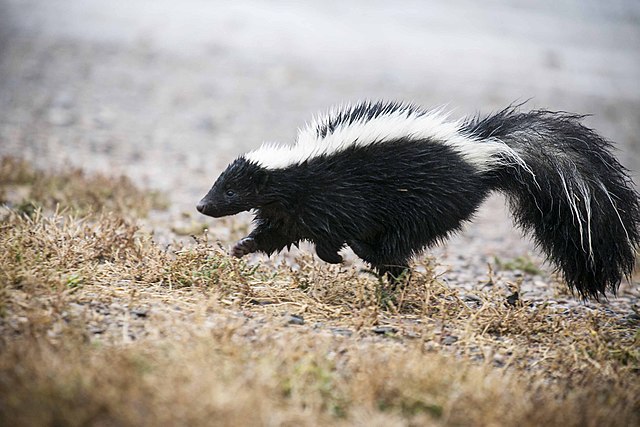
Back in 2019 I interviewed two prominent skunk researchers, the wonderfully-named Dr. Ted Stankowich and Dr. Jerry Dragoo. After talking to them I decided that if I were going to devise a Marvel-style comic book avatar for myself, it would be “Skunk Woman.” Rather than mostly in-the-way, non-aerodynamic objects of unwanted attention, my breasts would be repurposed as weapons that shoot noxious, tacky gel out of maneuverable nipples. Bold stripes in my fur would clearly signal what a bad idea it was to harass me. Don’t mess with me, they’d signal. I might be rabid.
It’s unseasonably warm right now, 70 degrees out, and the skunks seem to think it’s spring too, since an unusual number seem to be scampering out of their dens and ending up as roadkill. In tribute (and because the Sunday sunshine’s beckoning) here’s an old post about the most misunderstood of animals.
…
Late at night, after the campers at Puddingstone Lake RV park in Los Angeles County have gone to bed, Ted Stankowich and his graduate students set up infrared cameras and speakers around an open field. They open cans of cat food and fling chunks of it all over the grass. Then they wait.
The skunks come in droves. Some wear metal ear cuffs and RFID tags. Others are streaked with pink and purple dye, tagged in a previous run-in with the researchers. As the skunks nibble on cat food, Stankowich and his team cue up the sound of a coyote howling, or a great horned owl hooting. Then they watch to see if the skunks stand their ground, or scatter.
Stankowich studies how skunks respond to different predators, and how predators respond to them. Although skunks can easily fend off attacks at ground-level, they are much more vulnerable to predators that swoop from above, like great horned owls. The skunks seem more alarmed by the owl hoots, suggesting they know who they can and can’t tangle with, Stankowich says. His next step is to roll out more realistic models, including an owl glider that attacks from above and a robot named Obi Wan Coyote, he says.
Surprisingly little is known about skunk behavior for a simple reason: “People don’t want to get near them,” Stankowich says. Yet, “skunks are my favorite animal, and the most misunderstood.”
Among the many misconceptions Stankowich would like to clear up about skunks is that they stink. The oil skunks shoot from their anal glands does stink, he acknowledges. But skunks are so good at aiming their spray, using highly manueverable nipples, that they almost never get it on their own fur. Dr. Jerry Dragoo, head of the Dragoo Institute for the Betterment of Skunks and Skunk Reputations, concurs. Although the nipples do occasionally dribble, “the animal itself doesn’t smell worse” than any other furry mammal, he says. (Dragoo, it should be noted, has no sense of smell. He was born without one.)
Another myth is that skunks are aggressive, or that most skunks are rabid. For the most part, skunks have zero interest in spraying. In the five years Stankowich has spent trapping and releasing skunks, his team has only been sprayed twice, he says. The secret, he says, is to lure them into a Tomahawk trap with “a nice scoop of tuna,” and then sedate them. And although skunks are the most frequent carrier of rabies, he says, the prevalence of rabies is quite low.
Although he’s still testing the hypothesis, Stankowich suspects that their obnoxious spray gives skunks the confidence to be fairly relaxed in most situations. Dragoo, who has kept rescued skunk kittens under his desk, agrees. For the most part, he says “skunks are unconcerned.” Dragoo’s interest in skunks started young. “When I was growing up I was small, so I was interested in small animals that can defend themselves,” he says.
Very small mammals tend to hide and use camouflage for protection. But slightly larger mammals tend to use more aggressive tactics—particularly those between 1-10 kilograms, that forage in the open, Stankowich has found. Porcupines have spikes, armadillos have armour. Skunks have a rank smelling spray and bold stripes that alert predators not to mess with them. Among the mammals that have evolved stinky sprays — a small group including skunks and the striped African weasels known as polecats — Stankowich has found the bolder an animal’s stripes, the fouler its smell.
“It’s an honest signal,” he says. In other words, a healthy skunk isn’t going to chase you down or make a sneak attack, because it doesn’t need to.
On the other hand, if a skunk does start chasing you, that’s bad, Stankowich says. There’s a chance that it’s rabid, and you should run. Luckily, skunks aren’t very fast. Earlier in his career, when Dragoo spent long hours cruising down Texas highways picking up skunks to identify different species, he says, “I could easily outrun them.”
I asked Stankowich and Dragoo for their scientific opinion about my friend’s skunk encounter, several years ago. It was summer, and she was sleeping outside at a campground. At dawn, she awoke to find something licking her toes. At first she thought it was the camp cat. But it was not a cat. It was a skunk. Possibly several skunks. “Does that sound like something that could happen?”
Yes – particularly if my friend’s toes were salty or smelly. “I’ve had them walk under my feet and not care,” Stankowich says. “One day,” says Dragoo “I had sardine juice on my boot, and the skunk came up and licked my boot and kept going.”